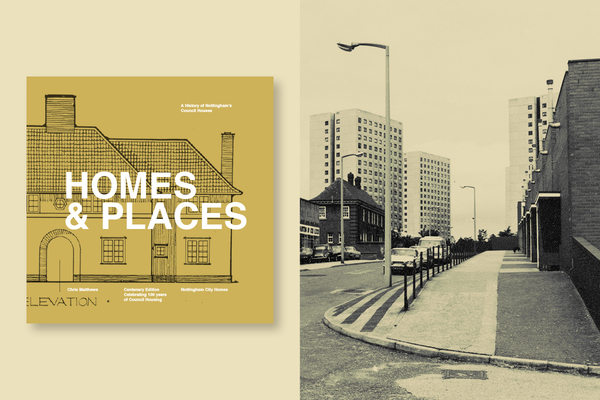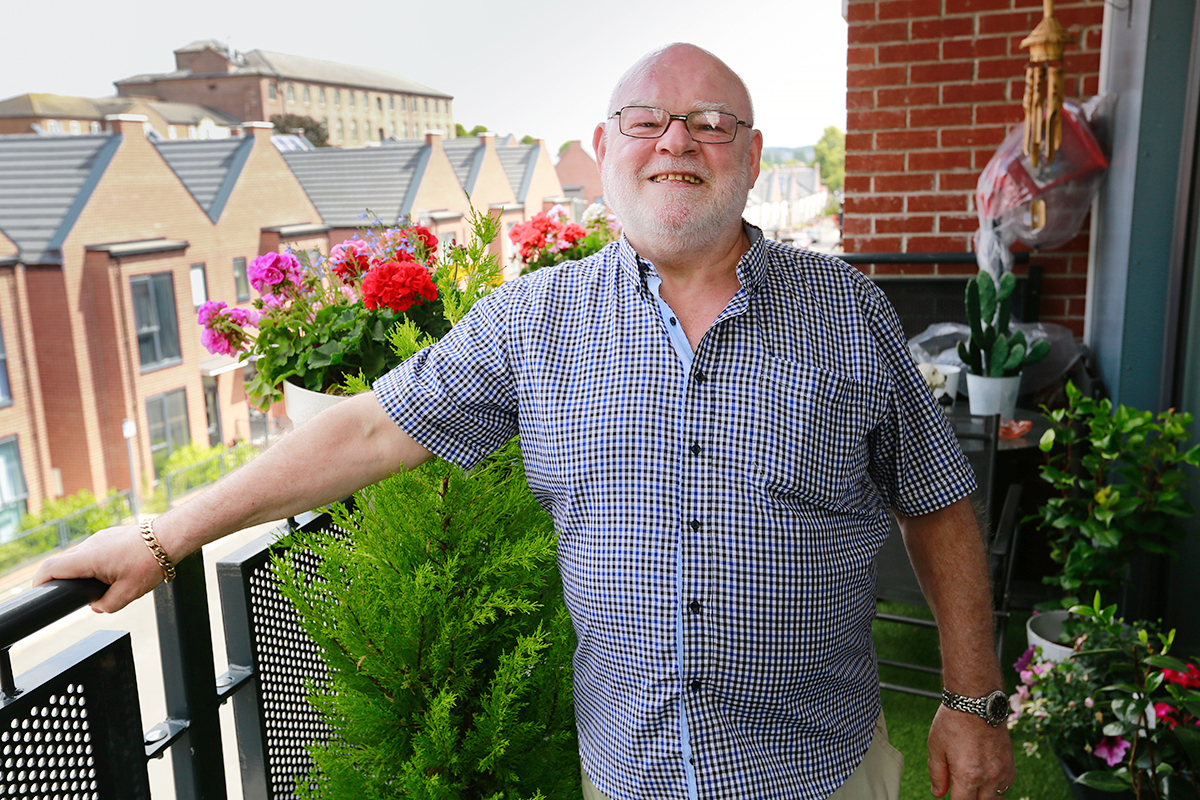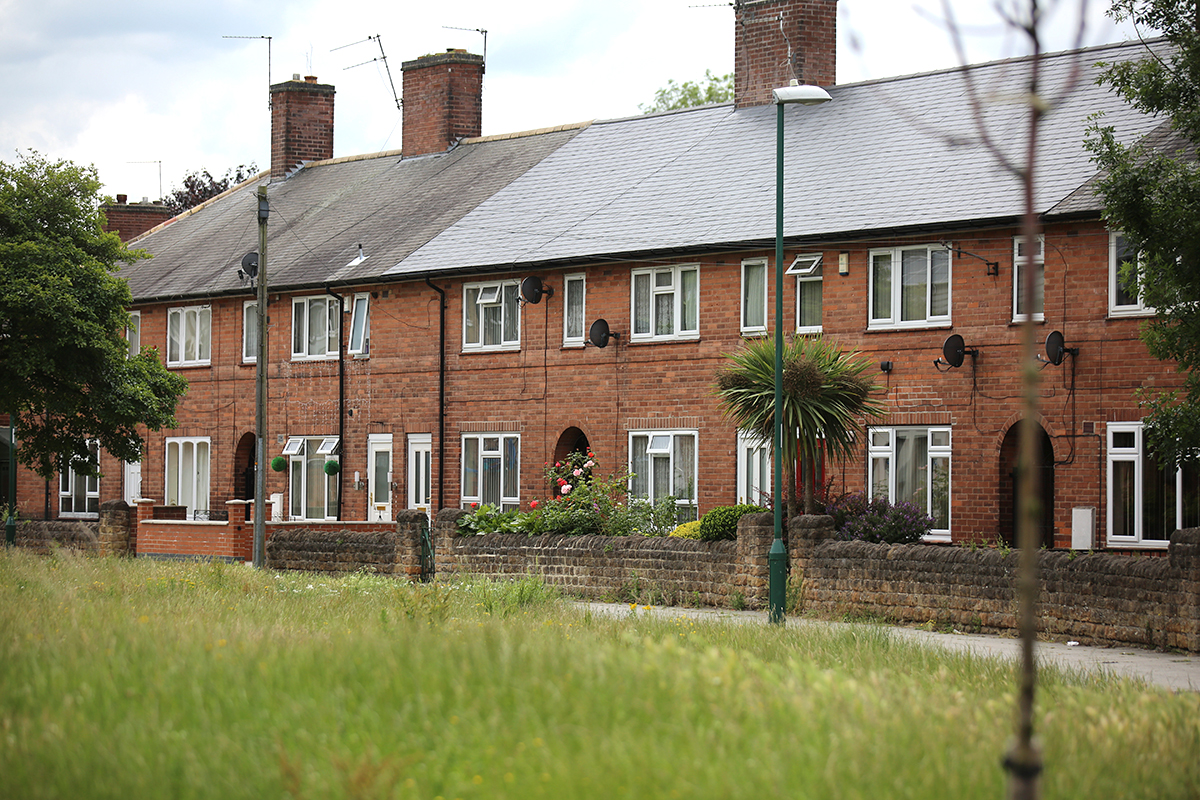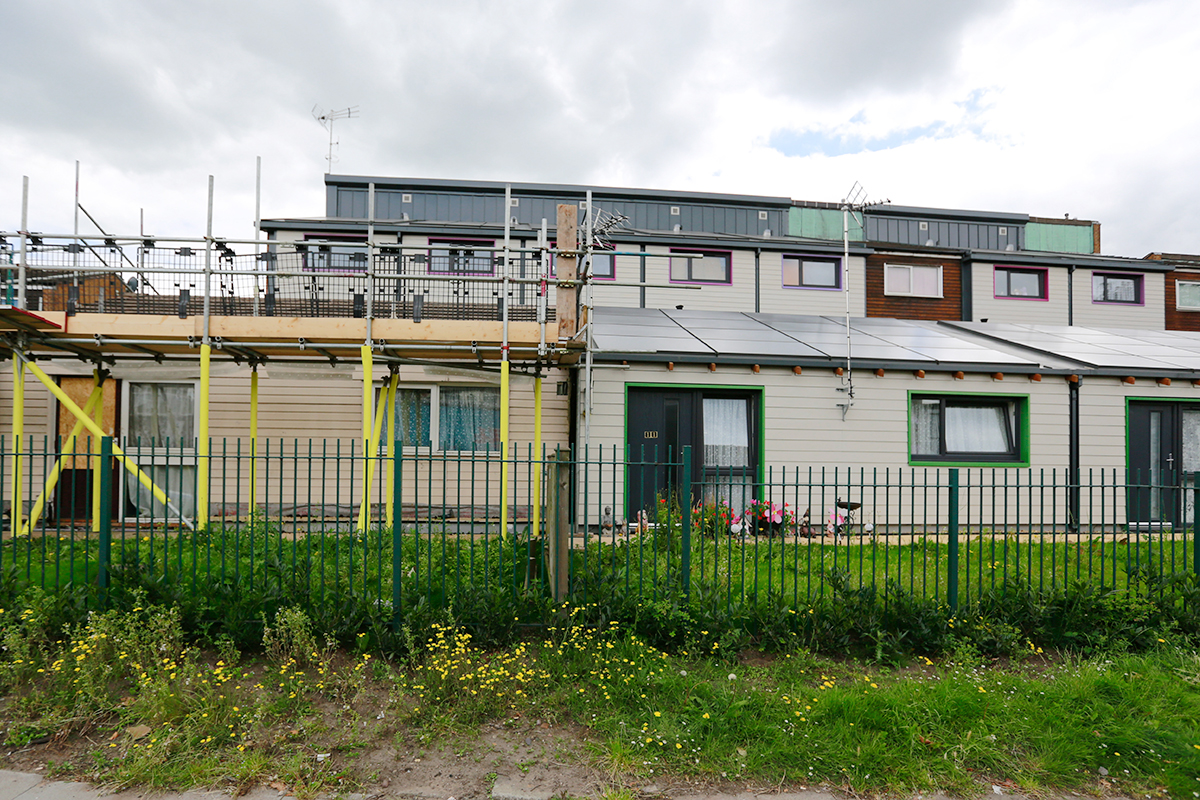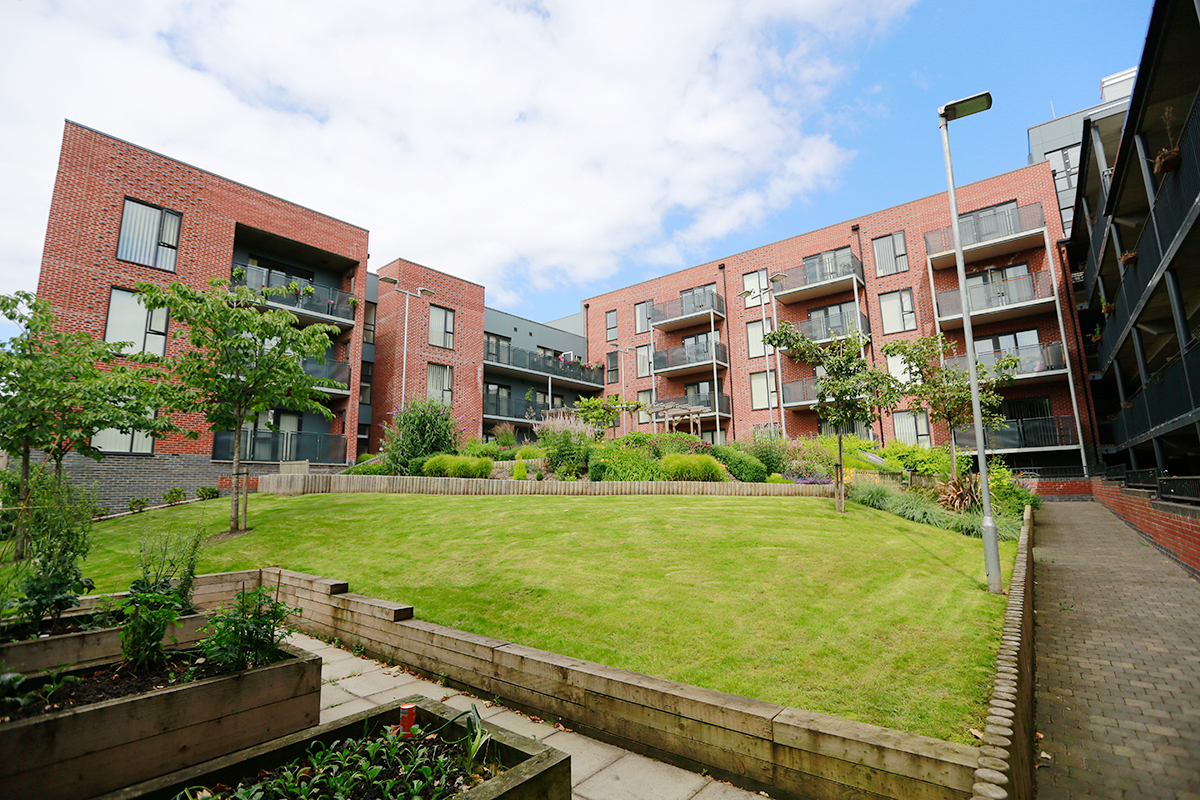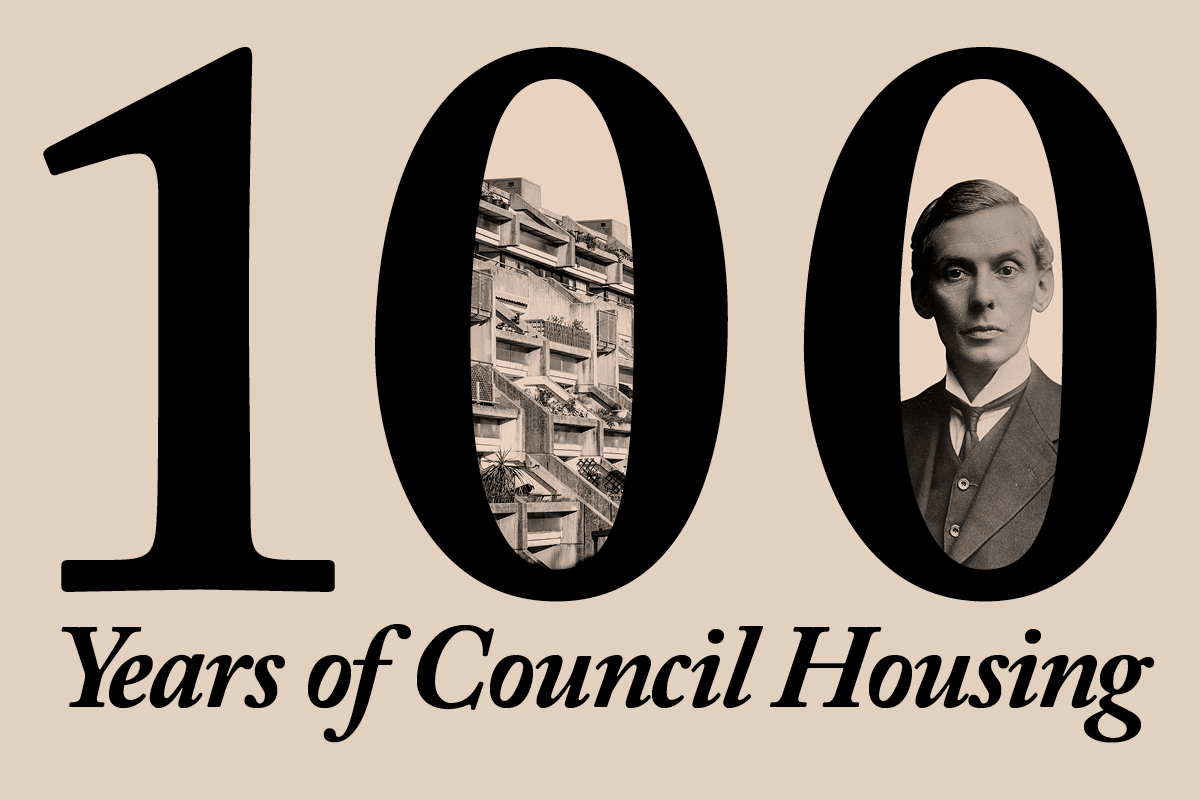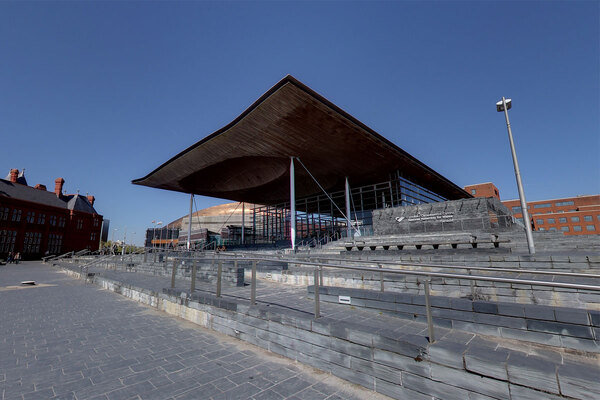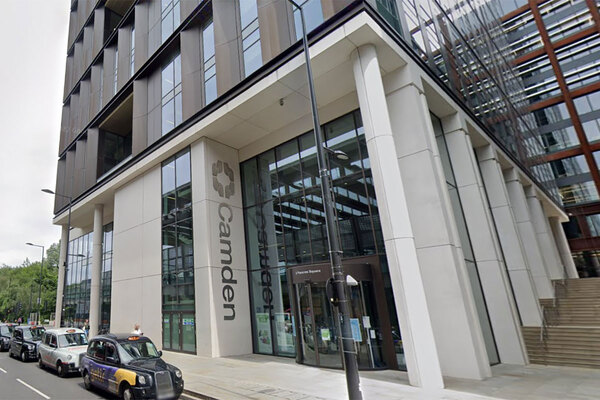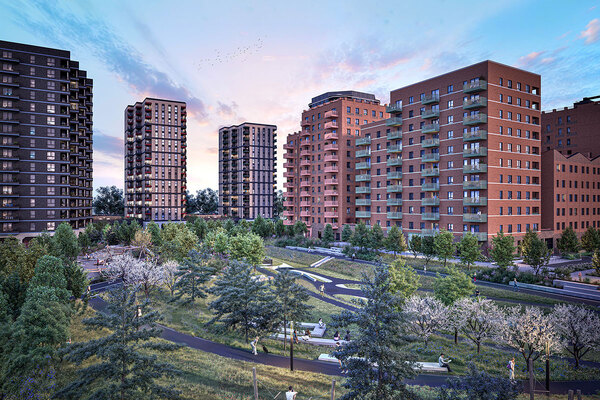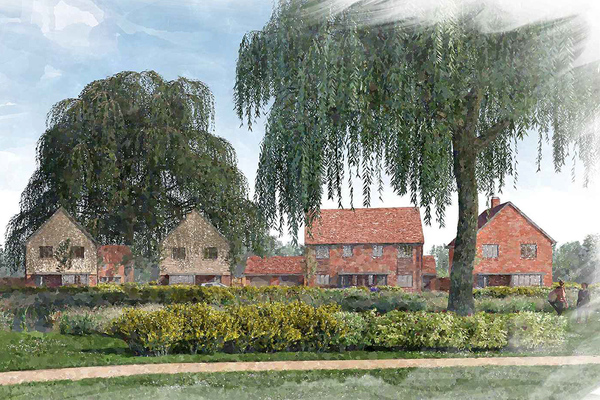100 years of council housing: Nottingham’s new wave
As part of our series on local authority housing through the ages, Robyn Wilson goes to Nottingham to see what the next generation of council homes are set to look like. Photography by SWNS and Picture Nottingham
Inside Housing is publishing a number of articles this month to mark the 100-year anniversary of the Addison Act, which paved the way for large-scale council housebuilding.
Home for 69-year-old Frank McCoid is a new two-bedroom council flat on Nottingham’s Lenton Green Estate.
Red-brick-clad and topped with solar PV panels, his building looks out onto a sizeable green, spotted with flower beds, benches and a large tree. It is a refreshing addition to Lenton’s concreted surroundings.
Long-term Nottingham resident Mr McCoid and his wife Pauline, 74, moved into the new property when their existing high-rise block across the road was earmarked for demolition in 2013 as part of a major new housebuilding drive by the council.
“There were five of the blocks altogether,” says the Glaswegian, pointing across the road to where their old flat once stood. “They were for over-60s, so we got first choice on a new home. We could’ve gone somewhere else in Nottingham, but we chose here, and we’re pleased we did.”
Hailed as the biggest building programme the city has seen in a generation, the council has focused on demolishing high rises deemed uneconomical to maintain or upgrade, such as the couple’s home on the former Willoughby Street Estate.
As part of a series of articles to mark 100 years of council housing, Inside Housing is in Nottingham to see how the local authority is delivering new supply to the market, and why it has taken a different approach to traditional council-led development.
Today, the McCoids live in an independent living community for older people, called Palmer Court (pictured above). It stands in stark contrast to the tall off-white towers it replaced and is a source of pride for the council and residents.
Inside, the flat is open plan, with wood flooring that the couple chose themselves with some of the £5,000 ‘disturbance money’ they received from the council as part of the move.
Floor-to-ceiling windows flood the room with light, as does a glass door that opens out onto a corner balcony. “The balcony makes a big difference,” says Mr McCoid, as he takes Inside Housing on a tour. “My wife sits out here when the sun is out.”
Palmer Court is surrounded by 88 semi-detached family homes that were built in part to redress an imbalance that had developed over the years between family and student accommodation. Falling between Nottingham’s two universities, Lenton has long been a popular home for students and it was hoped this estate would bring more families to the area. Certainly on Lenton Green, it appears to be doing the job.
When Inside Housing visits on a sunny Tuesday, three giggling children are playing on a trampoline in their garden. This greenery is a feature in all the homes and is something that Jonathan Shaw, director of investment and business services at Nottingham City Homes (NCH), the council’s ALMO and housing developer, is clearly proud of.
“If you were a private developer, you could’ve got a lot more on here and the housing would’ve been a lot smaller,” he says, as we look out onto the estate’s homes, all of which are affordable rented tenure.
“We could’ve gone somewhere else in Nottingham, but we chose here, and we’re pleased we did” Frank McCoid, resident, Lenton Green
We are joined by Mark Lowe, the council’s head of regeneration and housing delivery, who explains how the council opted to create high-quality housing for its residents by using an affordable rented model: “The old social rent formula, although it gives cheap rents, it’s not good in terms of its outcomes for new builds.”
Frank McCoid, a resident of Lenton Green
Based on an average for a three-bedroom home, social rent properties cost between £96 and £122 per week and affordable rent costs £126, with market rent at £158.
Mr Lowe adds that charging affordable rent means the council can afford to put features in the homes such as energy efficiency improvements, “whereas social rents don’t – they cause us to have too much debt”.
Energy efficiency improvements include better insulation and solar PVs, says Mr Lowe. And sustainability is a theme running across all of the council’s new stock, with Nottingham on a mission to be the UK’s first carbon-neutral city by 2028.
“The old social rent formula, although it gives cheap rents, it’s not good in terms of its outcomes for new builds” Mark Lowe, head of regeneration and housing delivery, Nottingham Council
Lenton Green is just one of the new estates that has been built since 2012 under the council’s programme, delivered and managed by NCH. Created in 2005, NCH took over from the council’s housing department and has built 524 homes, with 99 currently on site and 17 set to start soon.
NCH’s registered provider and commercial arm NCH Enterprises (which delivers housing under the brand name LiviNG) has also built new homes in the city, with profits reinvested back into the council.
Most of the 524 new homes are for affordable rent, with the exception of 57 homes delivered through NCH Enterprises at rents equivalent to social rent, although the tenancies are normally assured rather than secure. Mr Lowe says that any new homes delivered by the council will also follow these affordable rent or NCH Enterprises tenure models.
Mark Lowe and Robyn Wilson walk around the new Q blocks
Additional investment for the council’s new homes has come through its Housing Revenue Account, while some have received subsidy from Homes England.
Right to Buy receipts also play a part, covering 30% of development costs, but this did not apply to many of the early schemes delivered. Mr Lowe says that most of the 99 homes that are on site now, as well as the majority of the new housing, will be part-funded by Right to Buy receipts.
With around 8,500 people on the housing waiting list in Nottingham, Mr Shaw says that NCH’s focus to this point has been on delivering family homes. In the Meadows, a 55-home development is doing just that.
Located on the southern fringes of the city, this part of Nottingham is divided into two areas, Old and New, and the Meadows is anchored by the bleak-looking Bridgeway Shopping Centre. When it comes to housing, there is a distinction between the two areas, with Old Meadows being made up of pre-1919 privately owned terraced housing.
New Meadows, built during the 1960s and 1970s following slum clearances, is packed with Radburn-style homes – a design which typically sees the backyards of homes facing a common area and which has been criticised for encouraging anti-social behaviour and crime.
New Meadows is where the Q blocks were based, a mixture of four-storey, deck-access, grey maisonettes. The homes were popular with many residents – a ballot about demolishing the Q blocks back in 2012 saw 49% of residents that responded vote against the plans, but the council thought they were unlikely to last for another 30 years.
Old Q blocks homes
Mr Lowe explains how the council had private finance initiative plans for the area, which had to be modified once the 2010 coalition government pulled away from the initiative.
“We had to scale [our plans for the area] back a little but we still put a whole range of interventions in place, which included the demolition of all the Q blocks, replaced by a whole range of housing.”
In keeping with the council’s green goals, this included the construction of eco-homes built by Blueprint (a private building company that is jointly owned by the council and Places for People), as well as the 55 council homes (and six bungalows), which are set at affordable rent levels.
Walking around the revived Q blocks site today, its undeniable that the homes bring a refreshed feeling to this part of the New Meadows Estate.
When Inside Housing revisits on a Sunday morning, families are out enjoying the neighbourhood, including 39-year-old Ikopime Idiong, an international student from Nigeria.
She is just about to head out with her family and seems happy with her new home after moving in two months ago, although she admits she is a little disappointed with the size of the bedrooms. “One of the rooms is my son’s, but his bed can’t fit in so it’s not really a single,” she laughs.
Willoughby Street Estate in 1977. It has since been demolished
Around the corner, Italian-born Chiara Iacolano, 29, describes her new house as “an improvement” on the home she was living in. “We were renting and now we’ve bought this through the Right to Buy,” she explains, looking over to her husband Paulo, who is tending to their garden.
From the outside, the homes look well designed, with a brick exterior chosen to blend the new with the old. A freshly paved area on another part of the estate connects the site with 20 two-bedroom homes that are under construction across the road and due for completion in spring 2020.
The housing is having a wider impact, with an increased interest from the private sector. For example, Keepmoat is investing heavily in a 111-home scheme next door to where the Q blocks once stood.
Although arguably an aesthetic improvement on what was here before, the change is not universally loved. Linda, a 61-year-old Meadows resident from Nottingham, who did not wish to give her second name, seems less than impressed with the new buildings. She says the council is “knocking down council housing to sell it off to private developers”.
One area the council is clearly very focused on is sustainability. It is piloting a Netherlands-pioneered retrofit system on 10 of its homes in Sneinton to the east of the city. Known as Energiesprong, the retrofit includes new outside walls and windows, a solar roof and a heating system. The aim is to generate as much energy as the homes need with a view to making them almost zero net energy.
Energiesprong retrofit on homes in Sneinton
Regarded as energy inefficient, the 10 homes that were chosen for the pilot were built in the 1960s using timber and concrete. Today, they look like something you would find on a Dutch riverfront: white-clad, with modern flashes of pink and purple around their window frames.
A number of the old timber-fronted homes remain, sandwiched in between. It is a clash that is unavoidable due to Right to Buy sales.
Mr Shaw explains: “Some of the people who have exercised the Right to Buy are more well off, but they’re not so well off that they can afford [the retrofit]. Some of the homes may also be sublet, so the people who live there might not be the owners.”
Right to Buy is posing further difficulties for the city. Data from the council shows that in 1980 around half of the city’s population lived in council housing, but by 2005, 40% of council houses had been sold.
Palmer Court, Lenton Green
Today, Mr Lowe estimates that the council loses more than one property a day to Right to Buy sales.
“We’re putting so much work and effort into building new homes and buying second-hand, often ex-council properties back into our stock, using the Right to Buy replacement funds. But the problem is that we can’t keep up with the level of sales because they’re just selling so fast,” he says.
The council has stemmed some of that loss by delivering homes through its registered provider, which sits under the NCH Group and is not subject to the Right to Buy.
Meanwhile, it is ploughing ahead with the development programme and has an ambitious target to build or buy 1,000 new council houses by 2023, the majority of which will be affordable rent, says Mr Lowe.
Back at Palmer Court, a proud Mr McCoid finishes off his tour with a trip to the complex’s communal garden.
Pointing out a couple of the residents’ well-tended allotments on the way, he reveals another one of his wife’s favoured sunning spots. “You can’t get any better for a council house,” he grins.
100 Years of Council Housing: we want to hear from you
To mark the 100th anniversary of the act receiving Royal Assent in July, we have a month of special activities planned, including interviews with senior council housing figures, exclusive debate and comment, and investigations into what local authorities, past and present, are doing to help provide housing.
This will signal the start of a stronger focus on local authority housing issues over the coming months on www.insidehousing.co.uk and in our weekly print and digital editions.
We want to hear from you about your local authority is doing to mark the Addison Act and about the housing issues in your area, email: editorial@insidehousing.co.uk
Sign up to receive the latest housing news straight to your inbox through our exclusive Council Focus bulletin
If you are already a subscriber click here to manage your newsletter sign-ups
Click here to read more about our activity to mark the Addison Act
100 Years of Council Housing: what Inside Housing is doing
One hundred years ago, a piece of legislation led to the birth of council housing. Gavriel Hollander introduces Inside Housing’s celebration of the centenary of the Addison Act.
It is so ingrained in our national consciousness that it is hard to imagine just how radical the idea of local authority built and funded housing must have seemed a century ago. Before World War I, almost all housing in the UK was built by private developers (albeit with some notable municipal exceptions in major cities). Given this, it is unsurprising that both quality and consistency of delivery were variable.
The post-war introduction of subsidies for councils to solve the blight of slum estates was supposed to right a wrong and – in the words of then-prime minister David Lloyd George – provide “homes fit for heroes”.
The so-called Addison Act – the very first housing act passed in this country, named after its sponsor Dr (later Lord) Christopher Addison – received royal assent exactly 100 years ago this month.
It may never have achieved its aspiration of delivering 500,000 homes (something that may sound familiar to modern-day watchers of government housing policy) but it was the start of a movement.
New estates began to crop up across the country, built in accordance with recommendations from the Tudor Walters Report, which was produced to parliament in November 1918. This built on the ‘Garden City Principles’ and suggested a number of improvements to the standard of public housing. These included limiting the length of terraced-housing blocks, mandating a minimum number of rooms and providing indoor bathrooms.
“The post-war introduction of subsidies for councils to solve the blight of slum estates was supposed to right a wrong and – in the words of the prime minister David Lloyd George – provide ‘homes fit for heroes’”
Although the abandonment of subsidy in 1921 and a change of government the following year curtailed the immediate growth of council-built housing, the seed had been sown.
This month Inside Housing celebrates the centenary of the Addison Act with a month-long series of articles looking at how it transformed the social fabric of the country and created the housing sector we know today.
Over the course of this month, we visit four estates, each symbolising a different era of council housebuilding. We also take a look at whether new-found financial freedom for local authorities could be the catalyst for a new generation of estates.
To kick off the series, acclaimed social historian John Boughton visits one of the first estates made possible by Lord Addison’s historic legislation: Sea Mills in Bristol. We then travel to Stevenage to look at how the damage to Britain’s inner cities during the Blitz led to the new town movement and a fresh wave of estates through the 1950s and 1960s.
Martin Hilditch, editor of Inside Housing, takes a trip to Hulme in Manchester to examine how the private and public sector had to work together in the 1980s to deliver a regeneration project, which is still thriving more than 30 years later.
Finally, we go to Nottingham and look at one council with grand ambitions to provide housing to a new generation of tenants.
There may still be myriad challenges to face when it comes to providing good-quality, genuinely affordable housing for those most in need, but without the passing of an act of parliament 100 years ago, the sector we work in today may never have come to exist. That alone is worth celebrating.
To read more about the act, go to: www.insidehousing.co.uk/AddisonAct
More on the Addison Act
How George Clarke is aiming to end the housing crisis with his new TV show Architect George Clarke has long been a passionate campaigner for more – and better – council housing. As Inside Housing celebrates 100 years of the Addison Act, Martin Hilditch meets a man on a mission
100 Years of Council Housing: your tweets from week three Our favourite #100yearsofcouncilhousing tweets from the past seven days as our Addison Act activity moves into its fourth week
Nottingham's new wave Robyn Wilson goes to Nottingham to see what the next generation of council homes are set to look like.
If we’re going to have another 100 years of council housing, Right to Buy has to go The Right to Buy is having a devastating effect on the availability of council housing in this country and must be scrapped, writes Lee Sugden
What next for council housing? To celebrate the centenary of the Addison Act, Inside Housing asks a group of housing experts what can be learned from its legacy (sponsored)
Thatcher's legacy: a brief history of the Right to Buy An engine for social change or a handbrake on council development? We look at why the Right to Buy is as divisive as ever #ukhousing
A history of council housing: a timeline From the Addison Act to prefabs, slum clearance and the Right to Buy, council housing in the United Kingdom has a long and colourful history. Carl Brown looks at how it has evolved over time
Council housing: the key to a more equitable and dynamic society As the 100th anniversary of the Addison Act approaches, we publish an abridged extract of a book by Chris Matthews chronicling the history of council housing in Nottingham
Addison’s framework was scrapped but its legacy is more important than ever The fortunes of council housing have ebbed and flowed ever since Addison’s programme was abruptly halted in 1921, writes Jules Birch
Hulme: the redevelopment project that changed regeneration The redevelopment of Hulme in Manchester kick-started a new approach to regeneration in the UK – and the careers of some of housing’s best-known figures. Martin Hilditch joins them on a step back in time with lessons for today.
100 Years of Council Housing: your tweets from week two We pick our favourite #100yearsofcouncil housing tweets over the past week
Memories of council housing: the human legacy of the Addison Act As the centenary of the first council houses approaches, Peter Apps hears from some of the people who have lived in them in the decades since
Many of the sector’s current leaders began their journeys in council teams One hundred years of council housing has delivered a generation of sector leaders as well as millions of council homes, writes Mervyn Jones
Stevenage: home of the new town revolution Stevenage was the first of the post-war ‘new towns’. Gavriel Hollander visits the town to see how it has changed.
100 Years of Council Housing: your tweets from week one Inside Housing has been encouraging councils to say what they are doing to build homes and to mark 100 years of council housing. Here we feature a selection of your tweets
Kit Malthouse: 'Council housing is coming back with a vengeance' Housing minister Kit Malthouse tells Martin Hilditch why growing numbers of councils are looking to get back into development
Sea Mills: we visit one of the first estates to benefit from the Addison Act Social historian John Boughton visits a place in Bristol still cherished today
The Housing Podcast: is council housebuilding about to make a comeback Nearly 100 years after the introduction of the Addison Act, which kick-started the building of the first council estates in the UK, the Housing Podcast team examines the state of council housebuilding today
Why the 100th anniversary of the Addison Act should spark a council housing comeback Let’s make 2019 the start of a renaissance of council housing, writes Martin Hilditch
Are new borrowing freedoms sparking a revival of council housebuilding? The Addison Act marked the birth of council housebuilding. A century later, could recent financial freedom spark a renaissance? Nathaniel Barker investigates.
How Cornwall is taking inspiration from Christopher Addison Cornwall Council is one of many keeping the legacy alive, writes Kate Kennally.
The Addison Act - celebrating 100 years of council housing This year marks the 100th anniversary of the Addison Act – which paved the way for council housebuilding on a large scale. Inside Housing has a whole month of special activity planned and we want to hear your stories
The 100-year anniversary of the Addison Act means it’s time to talk about council housing Let’s use the 100th anniversary of council housing as we know it to flag up some of the great work that’s been done – and kick-start a conversation about the future, writes Martin Hilditch
London must recapture the housebuilding ambition of the Addison Act Councils are committed to development but are still facing unfair restrictions, writes Darren Rodwell of London Councils
Marking 100 years since the ‘Addison Act’ Professor Mark Swenarton writes about the Homes Fit for Heroes Centenary Conference
More council news
Council tenants on Universal Credit 16 times more likely to abandon tenancies
Council to claw back 260 Right to Buy homes
Local authorities accuse government of ‘sleight of hand’ over post-Hackitt regulation
Partner with housing associations to use borrowing freedoms, says LGA chair
Bristol City Council signs off partnership with L&G for 500-home scheme
Council boss warns against local authority ‘can't do’ attitude towards housebuilding
Right to Buy sales plummet 23%
Supreme Court rules against Birmingham Council in homelessness case
A bed every night: has Manchester's mayor succeeded in helping every rough sleeper in the city?
Council housing company to offer Rent to Buy
Council-owned regeneration company to build 500 homes
How has Haringey Council moved on from its development vehicle fight?
Liverpool to open HRA to build new council homes for first time in 30 years
How can London councils build more homes?
Birmingham Council’s housing company to build 2,708 homes by 2029
How are councils are using pension funds to build homes




